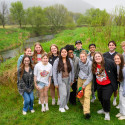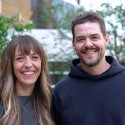Lowe brings Native arts to Smithsonian
When Truman Lowe speaks about his trip to Minnesota’s North Shore in early 2000 to visit with George Morrison, his voice conveys a deep respect.
Lowe, a professor of art, had been named curator of contemporary art for the Smithsonian’s National Museum of the American Indian (NMAI). He went to the Grand Portage Reservation of the Lake Superior Chippewa to seek permission to exhibit the works of Morrison, an internationally acclaimed abstract expressionist who had profoundly influenced Lowe and other artists of his generation.
Talking about the exhibit over four days seemed to strengthen Morrison, who at this time was mostly confined to his bed, according to Lowe. At their final meeting, Lowe recalls the two sitting silently for a long stretch of time, looking out over Lake Superior — the inspiration for many of the Ojibwa artist’s paintings. Finally, Morrison gave his blessing for Lowe to proceed. A month later, Morrison passed away.
Thus began Lowe’s remarkable journey, which culminated in September with the gala opening of NMAI in Washington, D.C. The newest Smithsonian museum opened with four major exhibitions: Our Universes (on Native philosophy), Our Peoples (on history), Our Lives (on contemporary life) and Lowe’s Native Modernism: The Art of George Morrison and Allan Houser.
Lowe, an acclaimed sculptor whose work is rooted in his Ho-Chunk heritage, returned to campus this fall after an extended leave to help develop the inaugural exhibition for the museum. His face lights up when he speaks of the experience, but he adds that he’s delighted to be back in the classroom.
He says he enjoyed simply watching the building on the National Mall rise from a hole in the ground. He visited the site many times, during various phases of construction. The design of the building, as well as the grounds, incorporates Native sensibilities and features curved walls that evoke a wind-sculpted rock formation. The curved walls present challenges for curators, Lowe notes.
The museum’s distinctiveness goes beyond its physical design. NMAI has a mission to bring together the past and present and to look to the future, Lowe explains.
“It’s the native interpretation of philosophy, history, our lives, resulting in the contemporary perspective that projects into the future,” he says.
The people whose histories, cultures and lives are on display have been involved. Lowe explains that “community curators,” who represent tribes, participate in planning exhibits. “The community in a sense curates the selection of objects,” he says.
Combining historic works and artifacts with contemporary art makes a significant statement, Lowe says.
“This history is ongoing. Natives have not disappeared; they’ve become active members of modern society,” he says.
For the inaugural exhibition of contemporary art, Lowe focused on Morrison (1919-2000) and Allan Houser (1914-94), a Chiricahua Apache widely known for his modernist sculptures. “These two artists were role models for my generation and succeeding generations of Native American artists,” he says, adding that he was fortunate to have known both. These two groundbreaking artists approached their art in different ways, but both rebelled against traditional views of Native art.
Lowe relished “the opportunity to honor two artists who have made a contribution to Native American art history.” His task involved locating, identifying and selecting artwork for the exhibit. The exhibition consists of 177 objects — 108 by Morrison, 69 by Houser — with items on loan from 20 public institutions and 26 private collectors.
“I exhibited their work as artists,” without any particular emphasis on their Native-ness, he says. He explains, “The intent of the exhibition is to establish the field of Native art history within American art history.” This exhibit recognizes that “Native artists have been creating art and have been a part of American art history.”
To accompany the exhibition, Lowe also edited a 128-page illustrated book, in which distinguished Native American writers and scholars — including N. Scott Momaday, Gail Tremblay and Gerald Vizenor — discuss the works of Morrison and Houser in the context of contemporary art, Native American art history and cultural identity.
While preparing the Native Modernism exhibition, Lowe also curated Continuum 12 Artists, a series of individual exhibits at NMAI’s George Gustav Heye Center in New York by Native artists, who have gone through the Euro-American art process but whose works retain a Native uniqueness.
Native Modernism will run for a year. Lowe says NMAI’s contemporary art exhibits will change periodically, and that he will continue to be directly involved.
To learn more about the National Museum of the American Indian, visit their Web site.
Lowe’s work is the subject of a recently published book, “Woodland Reflections: The Art of Truman Lowe,” by Jo Ortel. For details visit the book’s Web page .




